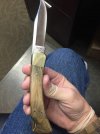Ankerson
Knife and Computer Geek
- Joined
- Nov 2, 2002
- Messages
- 21,094
I'm reminded of this Churchill quote...
"A fanatic is one who can't change his mind and won't change the subject."
--Winston Churchill
You and Singularity are the ones insisting that cost is determinative of quality. You've yet to make your case.
Please describe, in detail and without referring to cost, the quality differences between a Buck 110 (420HC, $30), a GEC #42 Micarta (1095, $95) and a Spyderco Byrd Cara Cara 2 Ti (8Cr13MoV, $65).
Or if you prefer, describe in detail and without referring to cost, the quality differences between a Buck 119 or Reaper, an ESEE 6 and a Becker BK16.
When you take away cost and if you set aside difference in designs... what you are left with to discuss is materials and construction quality. So where's the difference in material and construction quality among these knives to account for a 2 to 3 times cost increase if, as you repeatedly insist, the differences are cost related?
You haven't sat in on the marketing and research seminars that I have over the past 20 years.
You are confused I can tell because you are thinking like a customer.
My thought process is NOT the same.


